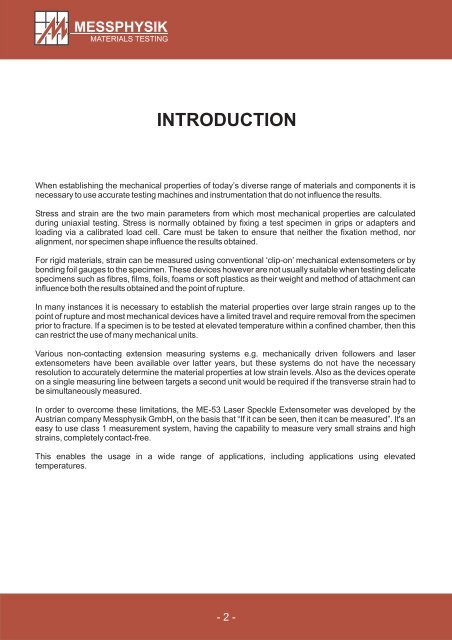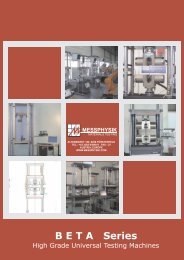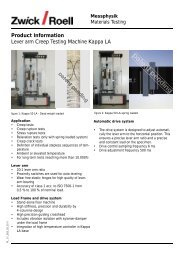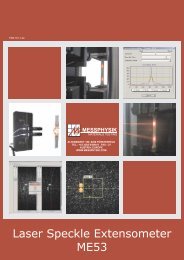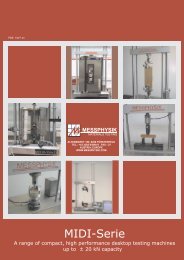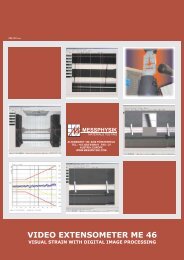Laser Speckle Extensometer ME53 - Messphysik
Laser Speckle Extensometer ME53 - Messphysik
Laser Speckle Extensometer ME53 - Messphysik
Create successful ePaper yourself
Turn your PDF publications into a flip-book with our unique Google optimized e-Paper software.
INTRODUCTION<br />
When establishing the mechanical properties of today’s diverse range of materials and components it is<br />
necessary to use accurate testing machines and instrumentation that do not influence the results.<br />
Stress and strain are the two main parameters from which most mechanical properties are calculated<br />
during uniaxial testing. Stress is normally obtained by fixing a test specimen in grips or adapters and<br />
loading via a calibrated load cell. Care must be taken to ensure that neither the fixation method, nor<br />
alignment, nor specimen shape influence the results obtained.<br />
For rigid materials, strain can be measured using conventional ‘clip-on’ mechanical extensometers or by<br />
bonding foil gauges to the specimen. These devices however are not usually suitable when testing delicate<br />
specimens such as fibres, films, foils, foams or soft plastics as their weight and method of attachment can<br />
influence both the results obtained and the point of rupture.<br />
In many instances it is necessary to establish the material properties over large strain ranges up to the<br />
point of rupture and most mechanical devices have a limited travel and require removal from the specimen<br />
prior to fracture. If a specimen is to be tested at elevated temperature within a confined chamber, then this<br />
can restrict the use of many mechanical units.<br />
Various non-contacting extension measuring systems e.g. mechanically driven followers and laser<br />
extensometers have been available over latter years, but these systems do not have the necessary<br />
resolution to accurately determine the material properties at low strain levels. Also as the devices operate<br />
on a single measuring line between targets a second unit would be required if the transverse strain had to<br />
be simultaneously measured.<br />
In order to overcome these limitations, the ME-53 <strong>Laser</strong> <strong>Speckle</strong> <strong>Extensometer</strong> was developed by the<br />
Austrian company <strong>Messphysik</strong> GmbH, on the basis that “If it can be seen, then it can be measured”. It's an<br />
easy to use class 1 measurement system, having the capability to measure very small strains and high<br />
strains, completely contact-free.<br />
This enables the usage in a wide range of applications, including applications using elevated<br />
temperatures.<br />
-2-


